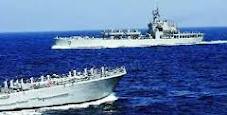
New Delhi, April 23: Slowly but surely emerging as a powerful three-dimensional "blue-water'' force to protect India's geo-strategic interests stretching from Hormuz Strait to Malacca Strait, the Navy is now also focusing on creating high-tech "sea warriors''.
The force, in fact, is steaming ahead with plans to ensure all its new officers have BTech degrees because of the unprecedented expansion in warship technology. "The advanced platforms we are inducting, with their state-of-art weapons and other systems, will require all officers to have cutting-edge technical knowledge,'' said Navy's assistant chief of personnel (HRD) Rear Admiral P Ajit Kumar.
"We already have a large number of MTechs, including in areas like nuclear technology. Moreover, we are also looking to send eight officers abroad every year for MTechs in niche areas. Our training pattern is in line with where the First World navies are headed,'' he added.
Navy's ongoing warship, submarine and maritime aircraft acquisition programmes as well as proposed projects in the pipeline will together cost well over Rs 3,00,000 crore over the next 15 years, as was first reported by TOI earlier.
With the "maritime capability perspective plan for 2012-2027'' pegging the number of major warships required at about 150, there are already 44 warships and six submarines on order. Moreover, contracts for another 45 warships, including six new submarines and seven stealth frigates, are in the pipeline.
All this will require a strong sea-warrior cadre. "The government has given us lot of manpower sanctions. We have to step up inductions as well as ensure quality manpower comes in,'' said Rear Admiral Kumar.
In tune with this, the first direct-entry batch of 70 BTech officers will pass out of the Indian Naval Academy (INA) at Ezhimala (Kerala) in June 2013. Plans are also afoot to get the existing BSc degree curriculum converted to a BTech one for naval cadets at the tri-Service National Defence Academy (NDA) in Kadakwasla (Pune).
"Naval cadets, who come to INA for their 7th and 8th semesters after passing out from NDA, get MSc (Tech) degrees as of now. But they will also get BTech degrees in the near future,'' he added.
Concurrently, INA is also set for a major expansion at a cost of around Rs 340 crore. From an existing annual capacity of 750 trainees, INA will begin training 1,200 cadets from 2015 onwards. Similarly, the "annual training load'' at INS Chilka will be enhanced to well over 4,500 sailors.
Overall, Navy plans to take the strength of its officer cadre from the existing 8,200 to over 11,000. Similarly, the number of sailors will be enhanced from the current 48,000 to over 60,000 by 2015 or so.
To cater for this, the Navy is also upgrading its selection infrastructure. There are plans for a new selection center at Vizag, with three SSBs (services selection boards), to add to the ones at Bhopal, Bangalore and Coimbatore. There will also be an additional SSB at Diamond Harbour at Kolkata by mid-2013.






Comments
Add new comment